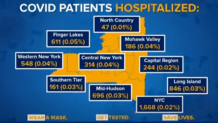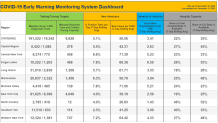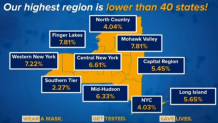What to Know
- Indoor dining will be suspended indefinitely in New York City as of Monday, Gov. Andrew Cuomo said Friday; it came the same day the city topped thresholds on the mayor's three indicators for 1st time
- In New York, state hospitalizations have topped 5,000 for the first time in nearly nine months; Gov. Cuomo debuted new rules for red, orange and yellow cluster zone areas tied to those rates
- Hospitalizations are also at May levels in New Jersey; state projections show they could top April peaks by early next year if public compliance with masks and distancing doesn't improve
Gov. Andrew Cuomo said Friday he is suspending indoor dining in New York City as of Monday, a result of sustained increases in the five boroughs' hospitalization and COVID-19 positivity rates. The potential for harsher shutdowns looms.
Mitigating increases in the state's hospitalization rate has become Cuomo's top priority -- and he recalibrated the state's micro-cluster model as part of a revised overarching post-holiday plan he unveiled Friday. That plan includes new standards for red, orange and yellow cluster zones and adjusted focus metrics.
If any region in the state is projected to hit 90 percent hospital capacity within 21 days, the governor will impose a red zone shutdown. That means nonessential businesses, schools and restaurant table service close in a given region for an indefinite period of time, a measure reminiscent of strict lockdowns from spring.
“If we don’t slow the spread and we overwhelm the hospital system — we get to a red zone... then every restaurant goes to zero indoor, outdoor zero. That’s the worst-case scenario,” he added.
Going forward, areas will be deemed orange zones if they are at 85 percent hospital capacity and a positivity rate of at least 4 percent for 10 days or the Department of Health determines hospitalization rates to be unacceptably high.
One other adjustment from previous rules: gyms and salons will be permitted to continue operating in orange zones with increased testing and reduced capacity (25 percent; the current limit on those businesses within non-orange zones is 33 percent). Cuomo said he made the change because says capacity limits and additional regulation have dramatically reduce spread in those places, as the state has said that transmission rates at those places has been lower than previously feared.
As for yellow zones, those will be areas with positivity rates of 3 percent or higher for 10 days that also are in the top 10 percent for hospital admissions per capita over the past week and see week-over-week growth in daily admissions. Cuomo says his team plans to review the latest data this weekend and will announce any new cluster zones Monday. He'll also reassess indoor dining outside the city.
The changes announced Friday are the core of Cuomo's revised winter plan, which prioritizes hospital capacity and acutely focuses on positivity rates, density, risk level of economic activity and rate of transmission. It's an interwoven strategy.
"We cannot relax until COVID relaxes — and COVID is not relaxing," Cuomo said.
New York City has a lower hospitalization rate than 3/4 of the state's regions and most major U.S. cities, but its density is a heightened risk factor. The new restrictions set to take effect Monday ensure that risk isn't underestimated.

The city also happens to have the least bed availability of the state's 10 regions after Long Island (18 percent and 19 percent, respectively). Cuomo said Friday that all statewide hospitals must remain below 85 percent capacity. They can reach that goal either by adding an extra 25 percent capacity, suspending elective surgeries or both. They have the flexibility, he said.
Medical outcomes have substantially improved since spring; the death rate is 8 percent, compared with 23 percent in the spring. Thirty percent fewer patients are in intensive care and 50 percent less are intubated. The average length of hospital stays has dropped from 11 days to just five days. This is good news, Cuomo says.
But the spikes in hospitalizations will by default generate some critical cases and more death. And the hospitalization rates are increasing at a rapid pace.
"This," Cuomo said Friday, "is the ultimate cause for concern."
Statewide, hospitalizations jumped to 5,311 Friday after topping 5,000 for the first time in nearly nine months a day earlier. Also Friday: New hospital admissions in New York City topped the mayor's 200 threshold for the first time since May 9.
The city's hospitalization rate per 100,000 residents has risen every day since Mayor Bill de Blasio debuted the new metric on Monday and is also above threshold, while the seven-day rolling positivity rate now stands at 5.35 percent.

"We've been holding the line up til now but this is a sign the hospitalization issue is becoming a bigger challenge -- and one that we're going to have to confront," de Blasio said.
Asked to comment on the anticipated new restrictions ahead of Cuomo's Friday briefing, de Blasio acknowledged shuttering indoor dining would hurt. The mayor said the return of it in November was credited with the restoration of about 100,000 jobs. But the priority has to be protecting public health, he adds.
"I feel tremendous empathy for restaurant owners, a lot of them are mom and pop businesses, we want them to survive. We need them to survive," de Blasio said. "At the same time, these numbers don't lie. For the first time unfortunately all three of our indicators are past their thresholds. That's a second wave. We have to fight it back to save lives. We have to fight it back to start our recovery."
Those who represent the city's restaurant industry, including the NYC Hospitality Alliance, argue it's unfair to close indoor dining in the five boroughs as restaurants upstate, where the hospitalization rate is double, are allowed to remain open.
"It will be the last straw for countless more restaurants and jobs," NYC Hospitality Alliance Executive Director Andrew Rigie said in a statement. "New York City’s restaurants have gone above and beyond in ensuring their businesses create a safe and healthy environment for their customers and employees that meet the state’s required safety protocols – at a significant cost – and it’s worked."
Mark Gjonaj, New York City Council's Small Business Committee Chair, called for finding "creative ways" to provide financial help for locally owned restaurants. He proposed that some of the possibilities to alleviate part of the burden includes things like "delaying the payment of a specific set of taxes such as payroll, sales and water and sewer charges; waiving license and permit fees; providing easily accessible and free PPE," and more.
While statewide hospitalizations today pale in comparison to the 19,000 admitted at the peak of the crisis in April, they are at their highest since May 19, and mark a steep increase over recent months for freshly beleaguered hospital staff and facilities. Cuomo has attributed part of the surge to Thanksgiving gatherings.
Household and small gatherings account for 74 percent of viral spread, based on contact tracing data. Restaurants and bars account for significantly less -- around 1.43 percent of exposures in September -- but the concern is magnified in an area as dense as New York City given the increasing numbers across the board.
The state's transmission rate is 1.3 as of Friday, Cuomo said. That's up from 1.2 on Monday and well above what the governor classifies as an "active outbreak." The raw numbers back that up. New daily cases have been on the rise, topping 10,100 in New York each of the last three days. Part of that is connected to increased testing but it also reflects a U.S. crisis that shows no signs of abating.
Despite its struggles, New York continues to fare better than most of the rest of the country. The Finger Lakes has the highest positivity rate of the 10 regions at this point, but even that 7.81 percent rate is lower than 40 states, Cuomo said.

The Race to Shore Up Hospitals in NJ
Hospitalizations have also become the core metric in neighboring New Jersey, which has seen sharp increases on that measure as well over the last 14 days. As of Friday, state hospitalizations stood at 3,571, the highest total since May 14.
Cases have been substantially rising too, but the hospitalization number is more important to Gov. Phil Murphy, as it is to Cuomo in New York.
"The one third rail we cannot touch is hospitals and hospital capacity," Murphy said Friday. Earlier this week, he said those are the numbers that come to determining the next steps he needs to take for the state.
Right now, those next steps do not include any plans to limit indoor dining anew. Asked yet again about the issue Friday, given Cuomo's announcement in New York and a new indoor dining ban in Pennsylvania, Murphy held tight.
"We're staying with what we got," the governor said. "We are trying to be as surgical as we can be."
While New Jersey is the densest state in the country, Murphy likens it overall more to Westchester County or Long Island, where indoor dining remains open at reduced capacity for now, than the high-density mecca that is New York City. Dine-in remains capped at 25 percent capacity in the Garden State, and its governor says there's no major evidence indoor dining is fueling the surge.
The governor has taken steps to improve compliance, including imposing a 10 p.m. curfew on bars and restaurants statewide. Those late-night hours were when usually compliant spaces turned into unmasked, crowded spaces, Murphy said.
On Friday, he announced varying crackdowns on nearly a dozen New Jersey bars and restaurants over repeat infractions. At least one could be shut for 70 days.
"Let these charges send a perfectly clear signal to any bar or restaurant owner who thinks that the rules don't apply to them. This will happen to you," Murphy said. "Our job is to protect both public health and our economy. We will not tolerate knucklehead behavior and we will not hesitate to shut you down."
Compliance -- both on the part and business and the public -- can't be underestimated as a weapon in the COVID fight. The worst-case and moderate projection models New Jersey debuted earlier this week underscore the point.
Under the nightmare scenario, which presumes no change in public behavior, daily case totals could double in a month and hospitalizations could climb to peaks not seen in April by mid-January. That level of strain could overwhelm the system.
Under the moderate outcome scenario, which presumes some increased level of public compliance with masks, social distancing and avoidance of gatherings, new daily cases would still climb but hospital levels would remain manageable.
The desperation to shore up hospital capacity and resources comes as state and local officials expect to get their initial shipments of the Pfizer vaccine within days, following the FDA's approval of the drug Friday.
States could begin doling out shots next week. They expect additional allocations from Pfizer and then initial allocations from Moderna, which the FDA panel takes up next week, before the end of the month. While welcome news, officials acknowledge the initial rollout won't help stem the COVID holiday tide.
Tracking Coronavirus in Tri-State
And that tide grows more fearsome by the day. New U.S. cases per day are running at all-time highs of over 209,000 on average. The number of people in hospitals nationwide for COVID-19 is setting records nearly every day. On Thursday, the country set a new single-day death toll, recording 3,110 fatalities.
The U.S. has already lost a world-high 293,000 people to the virus, according to data from NBC News. Dr. Robert Redfield, the head of the Centers for Disease Control and Prevention, has warned the U.S. could see its tragic toll near 450,000 by February without aggressive actions to contain the anticipated holiday surge on top of the surge that has been underway for weeks across the nation.



